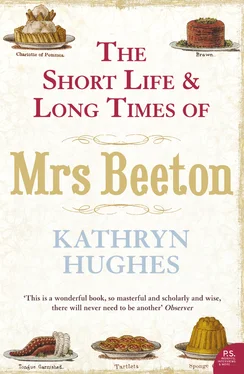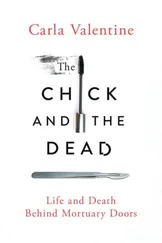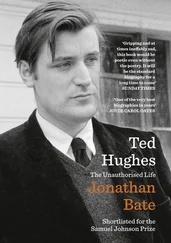Mayson Beeton would not have been pleased to hear Hake casually lumping his mother into a category of kitsch, brand-name Victorians. But then, he had never quite realized how lucky it was that some years previously Lytton Strachey, that arch pricker of Victorian pomposity, had abandoned his attempt to write a biography of Mrs Beeton. Strachey had been apt to tell friends that he imagined Mrs Beeton as ‘a small tub-like lady in black – rather severe of aspect, strongly resembling Queen Victoria’, which sounds as if he was lining her up for the kind of robust debunking delivered to Florence Nightingale and others in his Eminent Victorians of 1918. In the end Strachey had given up on his plans to write about Mrs Beeton because he could not find enough material, a continuing lack that explains why there have been so few biographies in total, and none at all since 1977.
Part of this absence is the result of the way that details about Mrs Beeton’s death – and hence her life – were suppressed almost from the moment she drew her last breath in 1865. In order to protect their investment in the growing ‘Mrs Beeton’ brand it made sense first for her widower Sam and then for Ward, Lock, the publishers who acquired his copyrights in 1866, to let readers think that the lady herself was alive, well, and busy testing recipes to go into the endless editions of her monumental work that were proliferating in the marketplace. For by 1880, with bestselling titles such as Mrs Beeton’s Shilling Cookery, Mrs Beeton’s Every Day Cookery and Mrs Beeton’s Cottage Cookery doing terrific business, Mrs Beeton had become the kind of goose whose eggs were solid gold. The emphasis now was on keeping her alive for as long as possible.
On top of this intentional censorship, the circumstances of Mrs Beeton’s life had managed to keep her hidden from history. She was only 28 when she died, which meant fewer letters written, fewer diaries kept and fewer photographs taken (the National Portrait Gallery picture is one of only two surviving adult portraits). After her death in 1865 the simmering tensions between her family, the Dorlings, and her widower flared into open warfare, and Sam broke off contact with her enormous brood of siblings. This naturally stalled the flow of anecdotes, ephemera, and memories about Isabella around her vast clan, and simultaneously created the conditions for rumour and innuendo to flourish, especially about what had actually happened during the nine years of her marriage. Sam’s own early death only twelve years later again acted as a kind of break in the transmission of accurate information about Mrs Beeton, while providing a further space for speculation and fantasy to grow. Brought up after Sam’s death by people who had never known Isabella, the two surviving children of the marriage, Mayson and his slightly elder brother Orchart, were left with only a small heap of fragments from which to reconstruct a mother they had never really met. There were forty or so love letters written between Sam and Isabella during their engagement in 1856, a couple of holiday diaries kept by Isabella from the 1860s, the increasingly famous photograph now hanging in the National Portrait Gallery, and that was about it. In these circumstances, half contrived and half chance, Mrs Beeton had slipped straight from life into myth.
So by 1932, and after decades of foggy indifference, the public was ready to be intrigued by the revelation that Mrs Beeton, whose name they knew so well, had indeed been a living, breathing person. In a slow week for news, the presentation of the little photograph to the public had provoked a gratifying amount of press coverage, all of which Mayson Beeton hungrily collected for the slight family archive. One writer set the approving mood when he declared:
It was with some astonishment that most of us learned during the week that never till the present year did the National Portrait Gallery possess a portrait of Mrs Beeton. Mrs Beeton, it will be generally agreed, is the most famous English authoress who ever lived. Her name is a household word in thousands of homes in which Jane Austen is as little known as Sappho. Other popular authoresses … appear and disappear; but Mrs Beeton has achieved the deathlessness of a classic as well as the circulation of a best-seller.
Other journalists followed this lead, waxing lyrical about a woman they had not bothered to think much about before, but were now happy to declare ‘the Confucius of the kitchen, the benefactress of a million homes’. The man from the Mirror made a careful distinction between Mrs Beeton as an exponent of proper ‘womanly’ ways as opposed to all the ‘“feminists” in the NPG, the suffragette, the actress and the long-distance flyer’. The Evening News , meanwhile, made the shrewd suggestion that part of this sudden interest in Mrs Beeton might be the fact that she spoke from a bygone world when ‘homes were homes, when cooks were cooks and above all when incomes were incomes and not illusory sums of money in uneasy transit from the pocket of trade and industry to that of the State’. For by 1932, and with Britain mired in economic depression, political uncertainty, and social unrest, it was easy to feel wistful for a time when middle-class homes could afford to keep a full complement of domestic staff, none of whom would think of answering back.
The point that all the commentators agreed upon was that the Mrs Beeton who stared down at them from the walls of the National Portrait Gallery was light years away from the Queen Victoria look-alike that they, along with Mr Strachey, had fondly imagined. The photograph was reproduced in countless newspaper articles, and even went on sale in August 1933 as a postcard in the National Portrait Gallery’s shop, where it quickly established itself as the third most popular portrait in the whole collection, after Rupert Brooke and Emma Hamilton. From being a virtually effaced person, ‘Mrs Beeton’ started to become one of the most widely recognized images circulating in British print culture.
There was something about the enigmatic young woman in the photograph that encouraged all kinds of speculations and projections. The critic from the Daily Express suggested that from Mrs Beeton’s body language it looked as if her cook had left the room a minute earlier (she didn’t have one), while another referred to her as effortlessly ‘patrician’, which she most certainly was not. The Express again mentioned ‘the firmness of the mouth’ while someone else talked about her ‘gentle’ face. The Guardian said it was reassuring to notice she was plump, while someone else talked about her elegant slenderness. The Mail , in the strangest flight of fancy, suggested that ‘it is perhaps fortunate that she lived in a pre-Hollywood age, otherwise her undoubted charm might have borne her away on the wings of a contract’. Margaret Mackail, who wrote a brief biographical sketch to appear on the back of the postcard, referred to Mrs Beeton as ‘lovely’, which seems generous, especially given that Mackail, the daughter and favourite model of the late Edward Burne-Jones, had herself been one of the iconic beauties of her day.
Four years later, and with the looming centenary of Mrs Beeton’s birth in 1836 provoking another wave of public interest, Mayson Beeton wrote an article entitled ‘How Mrs Beeton wrote her famous book’ for the Daily Mail , the paper for which he had worked as an administrator for so much of his career. The title was telling: Beeton’s driving concern was, as ever, to rescue his father’s professional reputation from the long shadow cast by his mother’s spectacular achievement. Hence, in Mayson Beeton’s retelling of the story to Daily Mail readers, ‘Samuel Orchart Beeton was the successful young publisher who at the age of 21 took Fleet Street by storm’, while Isabella was the ‘apt pupil’ who gradually learned how to produce articles for his array of publications. Most crucially, in the gospel according to Sir Mayson, the famous Book of Household Management was the outgrowth of the ‘weekly notes’ on cookery that his mother had contributed to his father’s Englishwoman’s Domestic Magazine . It says something about how little Beeton really knew about his parents’ lives that the Englishwoman’s Domestic Magazine had actually been a monthly publication.
Читать дальше












